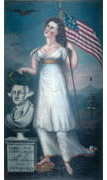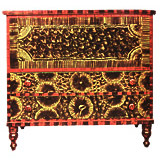American Fancy: Exuberance in the Arts, 1790–1840
Baker/Rowland and North Exhibition Galleries
Brilliant colors and wild patterns will be on view at the Milwaukee Art Museum April 3–June 20, 2004. Organized by the Milwaukee Art Museum, American Fancy: Exuberance in the Arts, 1790-1840 features more than 200 of the most ornamental and emotionally engaging artifacts ever produced in this country, including furniture, textiles, costume, ceramics, glass, metals, paintings and prints.
American Fancy offers playful visuals not seen before in the Milwaukee Art Museum’s Baker/Rowland Galleries. As visitors first enter the exhibition, they are surrounded by an audio-visual theater introducing the exhibition’s primary concepts. Upon strolling further through the galleries, visitors encounter the bright colors, vibrant patterns and imaginative designs that stirred the senses during this era of American history. A projector near the ceiling creates 12-foot kaleidoscopic images on the floor, depicting the “Kaleidoscope-Mania” that swept the nation in the early 19th century. From kaleidoscopes, visitors enter the two-story “Fancy Store,” and examine goods that were purchased during the era. Do-it-yourself home decorators will enjoy a section presenting types of decoration including marbling and graining, smoke painting, vinegar painting, scumble glazing, stenciling, and landscape painting.
Scholars in the field have long categorized the colorful and playful artifacts in the exhibition as “folk,” but during the period they were actually called “Fancy” and were mainstream designs for the 19th-century homes of the middle class.“ American Fancy will be the most invigorating and visually stimulating exhibition yet in the Museum’s new galleries,” said MAM Director and CEO David Gordon. “The exhibition’s ambitious and innovative design does more than display historic decorative arts; it captures the feeling of the era.” The exhibition begins with a presentation of Fancy’s 18th-century philosophical origins, before the concepts took form as Fancy goods in the 19th century. Additional topics covered include the surprising impact of the kaleidoscope on Fancy; the style’s unparalleled role in the marketplace; and the delightful range of decorative and sculptural techniques used by makers of Fancy goods.

This exhibition reveals Fancy’s remarkably broad appeal and its sophisticated origins. American Fancy is more than a simple story about an influential fashion in the arts—Fancy was as much a worldview as it was a style. Literary and philosophical trends, dramatic social changes and scientific inventions all contributed to the spirit of Fancy. American Fancy explores these larger cultural manifestations and the way they mirrored the youthful optimism of the new nation.
The exhibition is accompanied by a lavishly illustrated book published by the Chipstone Foundation of Milwaukee, Wisconsin. According to Jon Prown, the foundation’s executive director and chief curator, guest curator Priddy’s scholarly approach is both timely and innovative. “More than any other decorative arts work to date, American Fancy incorporates a wide range of scholarly perspectives to explain not only what things looked like, but also why these artifacts looked the way they did and how they were perceived by their original makers and users.” Employing an approach that is increasingly used in contemporary scholarship, the book integrates the research methods and analytical tools of diverse academic fields—including art history, material culture studies, literary, intellectual and scientific history, and psychology—to gain insight into Fancy and its relationship to early 19th-century American life.
The exhibition is sponsored by the National Endowment for the Arts, and the Wisconsin Humanities Council with funds from the National Endowment for the Humanities. Additional support provided by the Richard C. von Hess Foundation, Anne and Frederick Vogel III, the Kaufman Americana Foundation, and three anonymous donors. Support for lectures by guest curator Sumpter T. Priddy III is provided by the Faith R. and Willard F. Henoch Fund. Promotional support is provided by M Magazine and Milwaukee Journal Sentinel. In conjunction with the exhibition, the Chipstone Foundation is publishing American Fancy: Exuberance in the Arts, 1790–1840 by Sumpter T. Priddy III. This 250-page book, with full color photography is available in the Milwaukee Art Museum Store for $75 ($67.50 for Museum Members).
The exhibition is organized by the Milwaukee Art Museum in collaboration with the Chipstone Foundation. American Fancy: Exuberance in the Arts, 1790–1840 is guest curated by Sumpter T. Priddy III. A scholar and antiques dealer, Priddy lives in Alexandria, Virginia. The project, including the exhibition and the accompanying publication, is the result of his 25-year study of Fancy. The exhibition travels to the Peabody Essex Museum in Salem, Massachusetts, July 14–October 31, 2004 and the Maryland Historical Society, December 3, 2004–March 20, 2005.
- William Rice, Hotel Sign, 1834. Painted pine with wrought iron. Courtesy, The Connecticut Historical Society, Hartford, Connecticut.
- New England, Chest over Drawers, 1825–1840. Painted wood. Courtesy, American Folk Art Museum, Gift of Jean Lipman in honor of Cyril Irwin Nelson. Photo: Gavin Ashworth.
- England, probably Staffordshire, Jug, ca. 1820. Earthenware with slip decoration. Lent by a private collection. Photo: Gavin Ashworth.
- Unidentified Artist, “Liberty and Washington”, Window Shade, c. 1805. Oil on canvas. Courtesy of the Fenimore Art Museum, Cooperstown, NY.



